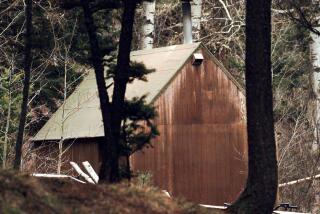Atomic Baby Boomers : TRINITY FIELDS: <i> By Bradford Morrow</i> (<i> Viking: $22.95, cloth, 435 pp.) </i>
OK, hereâs the deal. Los Alamos, N.M., 1944. You know, where we made the Bomb? Two guys born there, 11 hours apart on the same day, âbetween Christmas and New Years.â(Get it? Some time between the birth of Christ and the birth of the atomic Anti-Christ.) One is born in the morning, the other at night. Dig it. Light and dark, good and evil, yin and yang, war and peace, Laurel and Hardy, all that. Both named William, but called Kip and Brice. Grow âem up (as in âgrowâ the economy), give âem a few childhood bonding-type capers. You know, steal a car, get drunk, break into a religious shrine because theyâre so guilty about their parents building the Bomb. Send âem off to the same college. Columbia, say. Put âem through the whole â60s thing. They fall in love with the same girl. Yin goes straight, demonstrates against the War, gets the girl (unfortunately, along with Yangâs kid), law school, bleeding heart lawyer, full-metal yuppiedom. Yang gets really bent, joins up and heads to Vietnam, gets lost in Laos with some cloak-and-dagger spook operation.
Cut to: 20 years later. Bingo. Yang reappears in the form of a mysterious letter proposing a reunion with Yin on Good Friday. Just the two of âem, at the sacred religious spot where they pulled their midnight rendezvous with guilt and expiation so many years before.
Great story line. Problem is weâre talking novel here, not feature, not even miniseries. And the problem with novels is you gotta write âem. Prose fiction. You gotta show it, canât just tell it. Which is precisely where the trouble begins and ends for Bradford Morrow and his third novel, âTrinity Fields.â
First off, our co-protagonists--Yin, first-person narrator, Brice McCarthy (politically resonant name), and Yang, bad-boy, Kip Calder--are not so much characters as caricatures. They donât speak in individual voices, nor does anyone else in this novel, so much as mouth the authorâs rather mundane ideas about love, friendship, war, etc.
Sample:
âOne day Kip found me reading von Clausewitzâs massive book on the nature of war.
--Whatâs that for? he asked.
--Itâs a book. You know, they have words, you read them?
--Smartass, he said.
--I mean what class?
--Itâs not for a class, itâs just for myself.
--Youâre reading that for yourself?
--So what?
--Sometimes I just donât get you, boy.â
In case you donât get it, Kip goes on to explain to brainy Brice that âMen fight, Brice. Itâs what they do.â
Help.
As if these straw men running around werenât enough, Morrow has them dashing and ruminating in exotic locales--New Mexico, Vietnam, N.Y.C. and Laos--that are more backdrop than setting. I mean, if youâre going to use a place, hell, use it. In the old days, writers such as Hemingway, Greene and Chandler used physical settings and their descriptions of them--from hotel lobbies to the plains of Africa--as a means of showing the psychological, emotional, spiritual states of their protagonists. There was a direct sense of equivalence.
Oh, there are some naturalistic evocations, but they sound like theyâve been taken whole cloth out of a travel guide or some reference book. As Brice admits: âI knew my geography from school, Iâd always loved maps, and it was nothing for me to close my eyes and conjure the land and life that lay ahead of us. . . .â Exactly. Easy for you to say, Brice/Morrow, but Iâve lived here for a long time, and none of this looks or sounds familiar to me. (Kip and Brice burst into the âwhite morning heat of the plaza,â when anyone whoâs ever been here knows that even on the hottest day of the year thereâs no such thing as early-morning heat in Chimayo or anywhere else in northern New Mexico.) Eventually, you begin to wonder, with so many imprecise, just plain wrong observations about northern New Mexico, what can we expect when the novelist-narrator enters that tangled landscape of love, much less the jungles of Southeast Asia? You got it. More of the same.
There are a few pages at the end of this novel in which the author thanks a lot of people for their assistance in New Mexico and Southeast Asia research. But nothing beats the faithful recounting of personal observation and experience, or even the faithless fiction of imagination, all sadly missing in this novel.
But, it wasnât a bad idea. Two-characters-in-one spinning off from their birthplace of the Atomic Age into the â60s, splitting over Vietnam and a girl, and bringinâ it all back home to a sacred place, not far from where I sit, that today is more home to belief in the god of real estate than any spiritual faith.
Bet some agentâs pitching this novel around Hollywood right now. Sure thing. âI see Brad Pitt, I see Johnny Depp, I see. . . .â
The great thing is, the screenwriter and camera will show everything Morrowâs left out of his novel. Stuff like character, snappy dialogue, sense of place. This is one movie thatâll be way better than the book. Wait for it.
More to Read
Sign up for our Book Club newsletter
Get the latest news, events and more from the Los Angeles Times Book Club, and help us get L.A. reading and talking.
You may occasionally receive promotional content from the Los Angeles Times.








